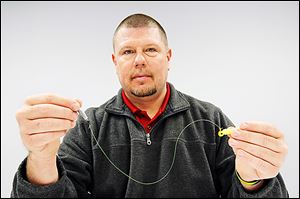
Potent walleye lures leave lead out
3/31/2013
Bob Barnhart shows an ideal river run walleye rig that he assembled at Jann's Netcraft in Maumee.
Anglers are an unusual study in contradiction. Most engage in an unending search to find the “secret” lure, technique or hot spot that will produce bragging-class success.
But while the hunt for an innovative edge is a relentless one, fishermen are also a highly skeptical lot, and demonstrate a firm hesitation to accept something new in place of a time-honored approach.
The legions of anglers that wade into the Maumee and Sandusky rivers each spring to take advantage of one of the largest migrations of freshwater fish in North America have traditionally pursued spawning walleye with one lure — the lead-headed jig.
This simple, artificial bait consists of a wire hook with a weighted lead head. The head is usually painted, and the hook is customarily dressed with a brightly-colored hair skirt, or with a soft, plastic grub-like lure with a curved tail.
Although this style of jig does not resemble a minnow or other food, like a crankbait or a plastic worm does, the hair skirt or plastic tail creates a certain action when pulled through the water, and this motion is believed to prompt fish to strike.
For decades, spring river fishermen have used the lead-headed jigs in their attempts to entice spawning walleye to bite. With their weighted heads, the jigs put the bait down in the irregular and rocky bottom, where most of the fish are located.
But the hooks often lodge in the rocks along the river floor, or foul-hook fish while the angler is retrieving the jig. Snagging fish is illegal, and any walleye not hooked in the mouth must be returned to the river immediately, according to the guidelines for fishing the spring run.
Snagging has been a persistent problem during the run, as has the mess of lead-headed jigs and strands of line left in the river when jigs have hung up in the rocks and been impossible to free.
About a decade ago, a trend toward a more innovative rig started to gain some momentum. A few anglers had always been experimenting with different lures, but in this case a noticeable minority was using a variation of the Carolina rig, a standard in the bass fisherman’s tackle box.
This rig puts a separate weight out in front of the actual lure or jig, and then attaches the lure to a separate section of leader. The weight pulls the rig down to the desired depth, but the jig or lure trails behind the weight, leaving the hook free from any material on the bottom.
Walleye fishermen in the area rivers are putting many variations of this floating jig assembly to use, but Bob Barnhart from Netcraft, a longtime Toledo area tackle supplier, said the anglers who have abandoned the lead-headed jigs are definitely now in the majority during the spring run.
“The trend has been moving in that direction for some time, and I’d say now that maybe 80 percent of the fishermen have changed to floating jigs,” he said. “There’s been a big shift in the approach most fishermen are using.”
Barnhart recommends using a solid foam floating jig with a No. 2 hook, an in-line sinker with a swivel on each end, a monofilament leader of about 18 to 24 inches, and attaching a three-inch-long twister tail to the hook.
“Guys don’t change their approach unless they see something else that works better, and what we’ve been hearing is that these floating rigs are just catching more fish,” Barnhart said. “There’s been a move toward lighter tackle too.”
Mike Wilkerson, fish management supervisor with the Division of Wildlife’s Findlay office, said while illegal snagging with lead-headed jigs during the spawning run remains an issue, most anglers use floating rigs.
“It has been evolving in that direction for some time, and lately we’ve seen a huge move to that style of rig,” Wilkerson said. “It is now the preferred choice of most fishermen who fish the walleye run.”
Wilkerson said the science behind the floating jig head rigs is sound, especially when applied to the usual conditions anglers encounter during the walleye spawning run — a swift current and a river bottom strewn with rubble.
“It keeps the hook up off the bottom and out of the debris, and it also presents the lure in front of the fish. With a lead jig, the fish has to work down into the rocks to pick it up,” Wilkerson said. “The floating jig style clearly results in less snags, so there is less tackle left in the river.”
That is a bonus for the folks who are involved in the stewardship of the rivers. Ava Slotnick, the outreach coordinator for Partners for Clean Streams in Perrysburg, is involved in projects each year to remove snagged lures and discarded fishing line from the Maumee River, once the water level drops and exposes the materials. Birds can ingest the lead-headed jigs, or become tangled in the broken off sections of line.
“It is definitely a good thing if there are less snags taking place, because that means less lead left in the river, and less fishing line,” she said. “It will certainly be safer for the wildlife that uses the river if we are keeping more of the lead and the strands of line out of there.”
Contact Blade outdoors editor Matt Markey at: mmarkey@theblade.com or 419-724-6068.